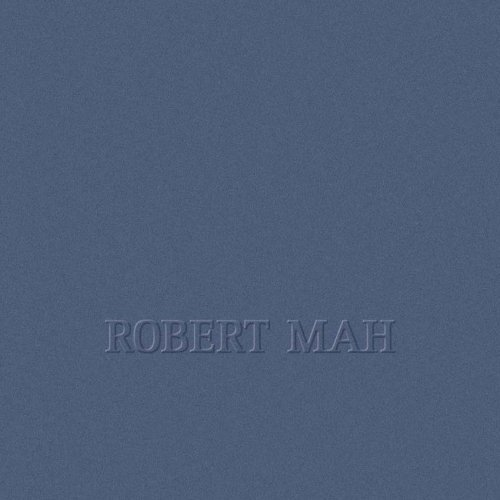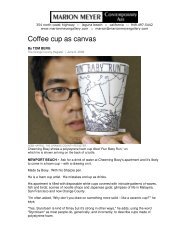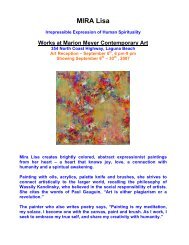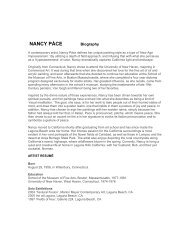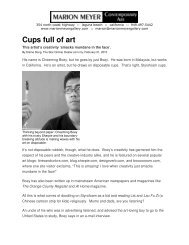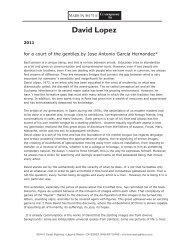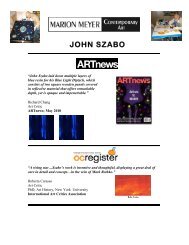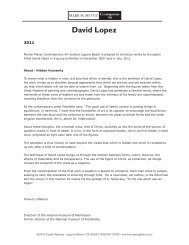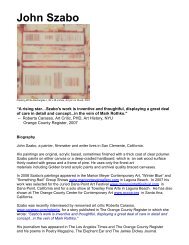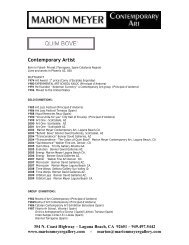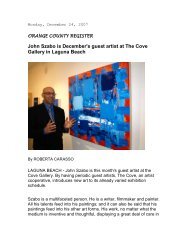robert mah - Marion Meyer Contemporary Art
robert mah - Marion Meyer Contemporary Art
robert mah - Marion Meyer Contemporary Art
Create successful ePaper yourself
Turn your PDF publications into a flip-book with our unique Google optimized e-Paper software.
γε α Κ ινιι ικι Πρταικ γ νεια
OPEN SPACES/PRIMARY COLORSPaintings, 2009Painting is about the beauty of space and the power of containment. —Sam FrancisThe leap from a monochromatic image to a vividly colored one has always opened eyes—whether it was photographs on the front cover of newspapers blooming into color or motionpictures (most famously in The Wizard of Oz) taking us from a Black & White monotone intothe Technicolor wonders of an imaginary world.To encounter Robert Mah’s most recent canvases in thisexhibition, Open Spaces/Primary Colors, is to experiencethis leap. Even for those who didn’t see his 2007 show,The Spontaneous Process, the bold, primary colors thatsplash across his newest canvases immediately grabthe eye. But for those who are familiar with those elegant,seemingly restrained works, the sight of these colorsis explosive.The two earliest paintings in this collection, Dancing Polymersand In Depth, share a connection to his previous exhibition.Like those works, they display a more controlled, mutedpalette: black paint on a white canvas, with only a fewsimilar-hued shades of blue and gray. In Depth resembles mostthose works, as it feels the most composed, the most formal.With Dancing Polymers we see the relaxed, more lyricalbrushwork, but still the almost monochromatic palette.Not just because of their unabashed use of color — at firstglance it would seem as if the artist was finally grantedpermission to use bright yellows and gleaming reds — butalso because of the freedom of the brushwork. Initially itlooks as if the careful, minimalist edges of his earlierpaintings have been wildly abandoned, like a chamberquartet suddenly breaking into rock and roll. But whenone looks closer at these canvases — at the pools of color,the varied textures and subtle restraint — instead of aradical departure or shift, Robert Mah’s new collectionrepresents simply a natural progression.As it turns out, the subsequent color canvases all startedout this way: the first paint to touch the surface is black.But soon, the vision shifts; Mah sees color and decides to“just go for it; let it happen.”It does.Pouring the paint onto the canvas and then using thesweep of his brush to let more of the paint drip onto thesurface in lyrical arcs and seemingly random dots, the red,green, yellow and blue takes form.
There is a performative aspect to these works—Mah paintedthem standing upright with the canvas horizontally onthe floor. But these are not simply Jackson Pollock-esqueaction paintings. His abstract interplay of color and whitespaces is more in the vein of Sam Francis, an artist whosework could look improvisational, even if his process wasmethodical and rigorous.Mah’s bright colors and playful brushwork suggests spontaneity;however, to look closer into the canvases is to seethe same precision, the same surety of composition thatexists in his previous landscapes (Above the Tree Line orBeyond the Himalayas) as well as his abstract portraits(Spatial Intelligence or Blue Forecast).you look closer) to “erase” some of the color. Looking atHeliotrope I, we feel this structure, but what we see is thedynamism and motion.During his tenure as a professor of microbiology at UCLA,Robert Mah saw the beauty of the world at the cellularlevel—he also no doubt saw how beauty and function interactedtogether. In this work, we see an artist who knowshow to render a sense of organic grace on canvas; and withhis artistic training and compositional instinct, he also takescontrol of the paint to subtly shift, focus, and clarify theforms our eye sees. The colors are what dazzle us at first,but it’s the carefully constructed rhythms and sense ofsymmetry Mah orchestrates that keep us mesmerized.There is a natural-ness to these new canvases, as if theirpatterns and shapes were seen under a microscope, at thesame time that they seem to have been released, or “let go”from Mah’s brush, like a butterfly freed from its pupa.However this feeling of spontaneity, just like the leap fromblack and white to color, is not entirely unplanned. It is theresult of an artist’s conscious (or at least subconscious)choices. The fact that the two canvases that make up thediptych titled Heliotrope I appear linked (and can also appearlinked when reversed) is the result of careful compositionboth before the paint is poured and afterwards, when Mahsteps back and uses white paint (often hard to spot untilJames C. TaylorJournalist, Critic
4Heliotrope I 36"H x 60"W each (60"H x 72"W diptych) Acrylic 2009
6Aquatic Spring I 24"H x 48"W Acrylic 2009
8Aquatic Spring II 24"H x 48"W Acrylic 2009
10In The Beginning 18"H x 24"W Acrylic 2009
Pre-emergent 18"H x 24"W Acrylic 2009
12In Full Bloom I 24”H x 24”W Acrylic 2009
In Full Bloom II 30"H x 30"W Acrylic 2009
14Phytophytes I 42"H x 48”W Acrylic 2009
16Algal Rhythms 24”H x 78”W Acrylic 2009
18Phytophytes II 42"H x 48"W Acrylic 2009
20Beckoning Summer 42"H x 56"W Acrylic 2009
22Harvest Festival 42”H x 48”W Acrylic 2009
24Blue Presence I 46”H x 52”W Acrylic 2009
26Spring Forth 42"H x 48"W Acrylic 2009
28In Depth 22"H x 28"W Acrylic 2009
Dancing Polymers 20"H x 24"W Acrylic 2009
30In Full Bloom III 16"H x 20"W Acrylic 2009
Larry’s Tank 18"H x 24"W Acrylic 2009
ROBERT MAHBorn in Fresno, CAra<strong>mah</strong>@ucla.eduEducationB.A. Bacteriology, 1958, UC DavisM.A. Microbiology, 1959, UC DavisPh.D. Microbiology, 1962, UC DavisTeaching Assistant Professor, 1961-1963BiologyDepartment of Biology, CSUN, Northridge, CAResearchAssociate Professor, 1963-1970Environmental MicrobiologyDepartment of Environmental Sciences and EngineeringUNC, Chapel Hill, NCProfessor, 1970-1995Environmental Micriobiology Department of EnvironmentalHealth Sciences, SPH, UCLA, LA, CAProfessor Emeritus, 1995-presentUCLA Department of Environmental Health Sciences,SPH, UCLA, LA, CAPhysiology and ecology of methanogenic bacteria and anaerobicEnvironments<strong>Art</strong> Classes Drawing, Painting, Ceramics, 1963-1970Department of <strong>Art</strong>, UNC Chapel Hill, NCExhibitionsPrivate CollectionsCeramics Summer Program with Toshiko Takaezu, 1970Penland, NCAnnual Juried <strong>Art</strong> Exhibition, SPH, UNC, Chapel Hill, NC1964, 1965, 1966, 1967, 1968, 1969Solo exhibition, <strong>Marion</strong> <strong>Meyer</strong> <strong>Contemporary</strong> <strong>Art</strong>, Laguna Beach, CAOctober, 2007Dr. and Mrs. D.G. Willhoit, Chapel Hill, NCDr. S. Nelson, Petaluma, CADr. P.H. Smith, Asheville, NCMrs. M. Mitchell, Chapel Hill, NCDr. and Mrs. S. Morse, Atlanta, GADr. and Mrs. E. Feiwell, Huntington Beach, CADr. and Mrs. James T. Staley, Seattle, WADr. and Mrs. Gareth Chang, Manhattan Beach, CAColleen Holthouse, Houston, TXDr. and Mrs. Morris Shiffman, Chapel Hill, NCDr. and Mrs. MJP Paynter, Clemson, SCChristine Nakamoto and Daniel Hsu, Newport Beach, CAMr. and Mrs. Harvey Witt, Sherman Oaks, CACopyright © Robert Mah 2009 Photographer ■ Victoria Damrel Printing and layout ■ Queen Beach Printers


